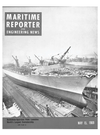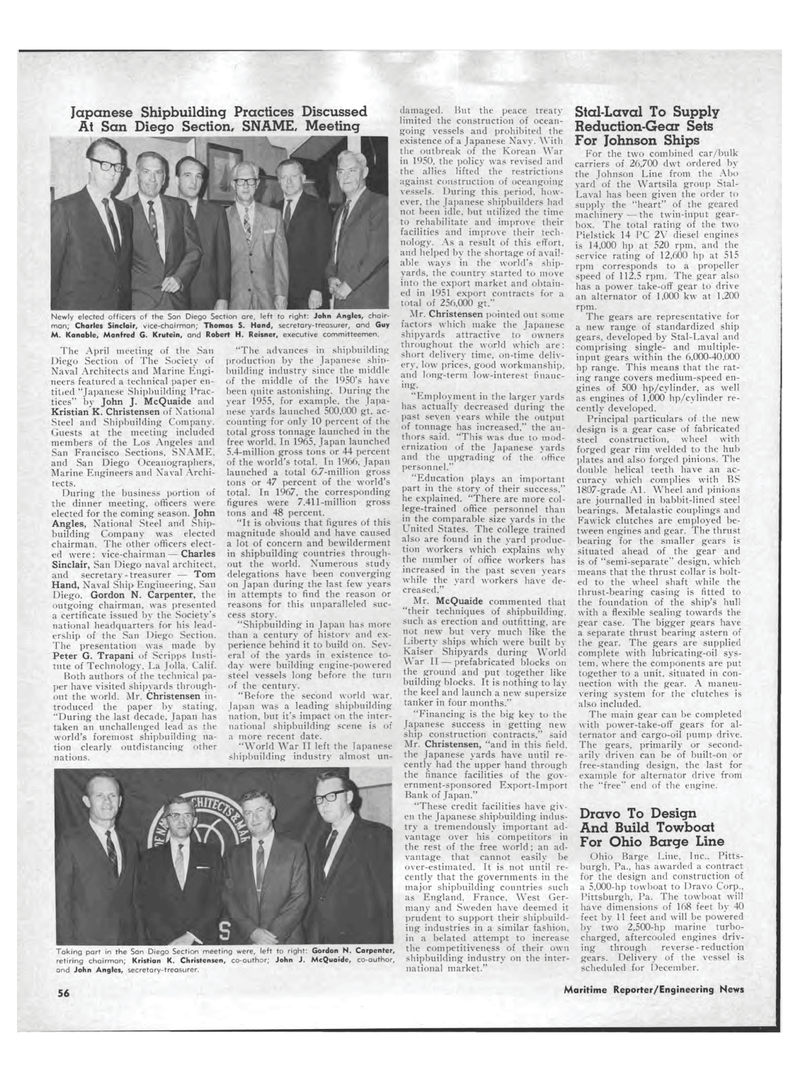
Page 52: of Maritime Reporter Magazine (May 15, 1969)
Read this page in Pdf, Flash or Html5 edition of May 15, 1969 Maritime Reporter Magazine
Japanese Shipbuilding Practices Discussed At San Diego Section, SNAME, Meeting Newly elected officers of the San Diego Section are, left to right: John Angles, chair-man; Charles Sinclair, vice-chairman; Thomas S. Hand, secretary-treasurer, and Guy M. Kanable, Manfred G. Krutein, and Robert H. Reisner, executive committeemen. The April meeting of the San Diego Section of The Society of Naval Architects and Marine Engi-neers featured a technical paper en-titled "Japanese Shipbuilding Prac-tices" by John J. McQuaide and Kristian K. Christensen of National Steel and Shipbuilding Company. Guests at the meeting included members of the Los Angeles and San Francisco Sections. SNAME. and San Diego Oceanographers, Marine Engineers and Naval Archi-tects. During the business portion of the dinner meeting, officers were elected for the coming season. John Angles, National Steel and Ship-building Company was elected chairman. The other officers elect-ed were : vice-chairman ? Charles Sinclair, San Diego naval architect, and secretary-treasurer ? Tom Hand, Naval Ship Engineering, San Diego. Gordon N. Carpenter, the outgoing chairman, was presented a certificate issued by the Society's national headquarters for his lead-ership of the San Diego Section. The presentation was made by Peter G. Trapani of Scripps Insti-tute of Technology. La Jolla, Calif. Both authors of the technical pa-per have visited shipyards through-out the world. Mr. Christensen in-troduced the paper by stating. "During the last decade. Japan has taken an unchallenged lead as the world's foremost shipbuilding na-tion clearly outdistancing other nations. "The advances in shipbuilding production by the Japanese ship-building industry since the middle of the middle of the 1950's have been quite astonishing. During the year 1955, for example, the Japa-nese yards launched 500.000 gt. ac-counting for only 10 percent of the total gross tonnage launched in the free world. In 1965, Japan launched 5.4-million gross tons or 44 percent of the world's total. In 1966. Japan launched a total 6.7-million gross tons or 47 percent of the world's total. In 1967, the corresponding figures were 7.411-million gross tons and 48 percent. "It is obvious that figures of this magnitude should and have caused a lot of concern and bewilderment in shipbuilding countries through-out the world. Numerous study delegations have been converging on Japan during the last few years in attempts to find the reason or reasons for this unparalleled suc-cess story. "Shipbuilding in Japan has more than a century of historv and ex-perience behind it to build on. Sev-eral of the yards in existence to-day were building engine-powered steel vessels long before the turn of the century. "Before the second world war. Japan was a leading shipbuilding nation, but it's impact on the inter-national shipbuilding scene is of a more recent date. "World War II left the Japanese shipbuilding industry almost un-Toking part in the San Diego Section meeting were, left to right: Gordon N. Carpenter, retiring chairman; Kristian K. Christensen, co-author; John J. McQuaide, co-author, ond John Angles, secretary-treasurer. damaged. But the peace treaty limited the construction of ocean-going vessels and prohibited the existence of a Japanese Navy. With the outbreak of the Korean War in 1950, the policy was revised and the allies lifted the restrictions against construction of oceangoing vessels. During this period, how-ever. the Japanese shipbuilders had not been idle, but utilized the time to rehabilitate and improve their facilities and improve their tech-nology. As a result of this effort, and helped by the shortage of avail-able ways in the world's ship-yards, the country started to move into the export market and obtain-ed in 1951 export contracts for a total of 256.000 gt." Mr. Christensen pointed out some factors which make the Japanese shipyards attractive to owners throughout the world which are: short delivery time, on-time deliv-ery. low prices, good workmanship, and long-term low-interest financ-ing. "Employment in the larger yards has actually decreased during the past seven years while the output of tonnage has increased," the au-thors said. "This was due to mod-ernization of the Japanese yards and the upgrading of the office personnel." "Education plays an important part in the story of their success," he explained. "There are more col-lege-trained office personnel than in the comparable size yards in the United States. The college trained also are found in the yard produc-tion workers which explains why the number of office workers has increased in the past seven years while the yard workers have de-creased." Mr. McQuaide commented that "their techniques of shipbuilding, such as erection and outfitting, are not new but very much like the Liberty ships which were built by Kaiser Shipyards during World W ar II ? prefabricated blocks on the ground and put together like building blocks. It is nothing to lay the keel and launch a new supersize tanker in four months." "Financing is the big key to the Japanese success in getting new ship construction contracts." said Mr. Christensen, "and in this field, the Japanese yards have until re-cently had the upper hand through the finance facilities of the gov-ernment-sponsored Export-Import Bank of Japan." "These credit facilities have giv-en the Japanese shipbuilding indus-try a tremendously important ad-vantage over his competitors in the rest of the free world; an ad-vantage that cannot easily be over-estimated. It is not until re-cently that the governments in the major shipbuilding countries such as England, France. West Ger-many and Sweden have deemed it prudent to support their shipbuild-ing industries in a similar fashion, in a belated attempt to increase the competitiveness of their own shipbuilding industry on the inter-national market." Stal-Laval To Supply Reduction-Gear Sets For Johnson Ships For the two combined car/bulk carriers of 26.700 dwt ordered by the Johnson Line from the Abo yard of the Wartsila group Stal-Laval has been given the order to supply the "heart" of the geared machinery ? the twin-input gear-box. The total rating of the two Pielstick 14 PC 2Y diesel engines is 14.000 hp at 520 rpm, and the service rating of 12,600 hp at 515 rpm corresponds to a propeller speed of 112.5 rpm. The gear also has a power take-off gear to drive an alternator of 1,000 kw at 1.200 rpm. The gears are representative for a new range of standardized ship gears, developed by Stal-Laval and comprising single- and multiple-input gears within the 6,000-40.000 hp range. This means that the rat-ing range covers medium-speed en-gines of 500 hp/cylinder, as well as engines of 1,000 hp/cylinder re-cently developed. Principal particulars of the new design is a gear case of fabricated steel construction, wheel with forged gear rim welded to the hub plates and also forged pinions. The double helical teeth have an ac-curacy which complies with BS 1807-grade Al. Wheel and pinions are journalled in babbit-lined steel bearings. Metalastic couplings and Fawick clutches are employed be-tween engines and gear. The thrust bearing for the smaller gears is situated ahead of the gear and is of "semi-separate" design, which means that the thrust collar is bolt-ed to the wheel shaft while the thrust-bearing casing is fitted to the foundation of the ship's hull with a flexible sealing towards the gear case. The bigger gears have a separate thrust bearing astern of the gear. The gears are supplied complete with lubricating-oil sys-tem. where the components are put together to a unit, situated in con-nection with the gear. A maneu-vering system for the clutches is also included. The main gear can be completed with power-take-off gears for al-ternator and cargo-oil pump drive. The gears, primarily or second-arily driven can be of built-on or free-standing design, the last for example for alternator drive from the "free" end of the engine. Dravo To Design And Build Towboat For Ohio Barge Line Ohio Barge Line. Inc.. Pitts-burgh. Pa., has awarded a contract for the design and construction of a 5,000-hp towboat to Dravo Corp.. Pittsburgh, Pa. The towboat will have dimensions of 168 feet by 40 feet by 11 feet and will be powered by two 2.500-hp marine turbo-charged, aftercooled engines driv-ing through reverse - reduction gears. Delivery of the vessel is scheduled for December. 56 Maritime Reporter/Engineering News

 51
51

 53
53
